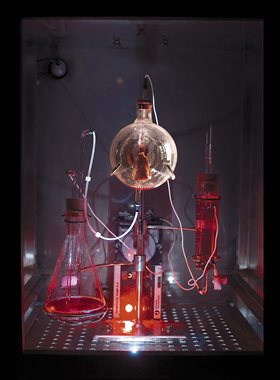.aspx) Too busy to beg
Too busy to beg
Oron Catts by June Moorhouse
SymbioticA has become a world famous organisation attracting the most significant artists interested in biological art.
In 1996 Oron Catts and Ionat Zurr began to use live tissue cultures to “artistically explore and provoke ideas about human conduct with other living systems.” Their Tissue Culture & Art Project quickly gained traction internationally and in 2000 a pioneering and generous partnership with Lotterywest and the University of Western Australia saw the establishment of SymbioticA, an artistic research laboratory within UWA’s biological science department.
In the past 14 years SymbioticA has become a world famous organisation attracting the most significant artists interested in biological art, with many undertaking substantial residencies.
Meanwhile Oron spends much of his time away from Perth responding to myriad international requests for his contribution in a variety of roles; engaging and working with fellow artists, cultural theorists, scientists, ethicists, philosophers and research colleagues across the globe.
SymbioticA has shown work in Japan, China, across the US and Canada and throughout Europe. Oron has projects underway in Finland, Japan and China and advises on the establishment of similar arts-science research projects across the world. None, he notes, match the depth of support and endeavour that has developed here in Perth at UWA.
Given the seriousness with which SymbioticA’s research and creative output is regarded world wide, where is its profile at the Art Gallery of WA? Nowhere… SymbioticA’s work has not been collected or exhibited by the gallery. “They did ask me once to take part in Art in Bloom,” laughs Oron, “but I had to decline, explaining that as an artist working with living tissue, I couldn’t involve myself with the amputated sexual organs of plants.”
 A deeper irony exists in the recent demise of AGWA’s MoMA series, given that Tissue Culture & Art Project’s work gained international attention when its Victimless Leather was presented at MoMA in the 2008 exhibition Design and the Elastic Mind. The cells of the victimless leather coat grew out of control during the run, and the exhibit’s life support system was turned off, literally killing the artwork. This incident propelled the already highly regarded laboratory and its leaders into a world of complex and sophisticated ethical debate.
A deeper irony exists in the recent demise of AGWA’s MoMA series, given that Tissue Culture & Art Project’s work gained international attention when its Victimless Leather was presented at MoMA in the 2008 exhibition Design and the Elastic Mind. The cells of the victimless leather coat grew out of control during the run, and the exhibit’s life support system was turned off, literally killing the artwork. This incident propelled the already highly regarded laboratory and its leaders into a world of complex and sophisticated ethical debate.
Oron is quick to point out that AGWA Director Stefano Carboni was personally very supportive of SymbioticA when he first arrived in Perth. Coming from The Metropolitan in New York, Carboni was familiar with SymbioticA and the debate arising from Victimless Leather but, according to Oron, had no idea that this fertile creation had grown in his new back yard.
Does it matter that SymbioticA is absent from our state gallery while prominent around the world and at other state galleries within Australia? “I would love to show the work locally, this is my home,” says Oron, “but to be honest it doesn’t make sense to spend my time chasing those opportunities when I am having to refuse requests internationally because there is not enough time.”
There may be few lost opportunities for SymbioticA and Oron Catts, but for WA? The Art Gallery of WA could be a world leader in understanding, archiving and presenting the dynamics of this unique area of contemporary arts practice and build on having one of the most significant bodies of knowledge on its doorstep.
June Moorhouse is the editor of Artsource Magazine. She has worked in the arts for 30+ years and has managed major arts organisations and events. She now works as an independent consultant.
This article featured in the Artsource Newsletter, Autumn 2014.